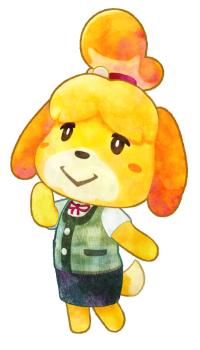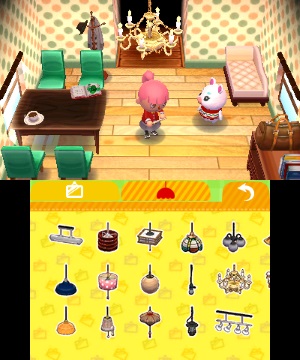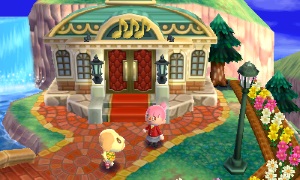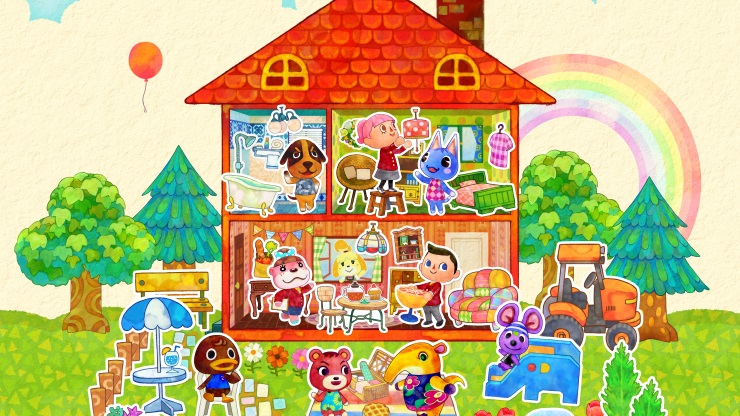To me, there is one thing that sums up what Animal Crossing is all about: Turnips. All the fun and stress of commodity trading wrapped up in the wait for that ideal price. If you missed your window, if you were too late, then that was it; you had no way of turning back time. When you closed the lid, switched off and went and did something else, your little village kept on going. The weeds would grow, residents would move in and out, others would lambast me when my daily visits had moved to weekly and then finally monthly. Meanwhile, the turnip prices just kept on changing. It was part of the game’s subtle addiction mechanics – it made you play so you didn’t miss out on that all important price..
There are no obvious root vegetables in Animal Crossing Happy Home Designer. This might be a point of concern for some of you. There is, however, Tom Nook, who is as reassuringly bold and brash as normal. You are the latest recruit in Nook Homes, taking up your position as trainee designer with a view to providing all the local residents with your unique design skills, which expand and mature as you go through your day to day job, listening to your clients requests, designing the interiors and exteriors of their domiciles and getting the chance to build local facilities for the residents.
 And then there’s the wonderful Isabelle, in charge of providing you with facility jobs as part of the town improvements. Someone has obviously had a promotion since their days in the Mayor’s office in New Leaf. Lyle makes an appearance as well as one of your fellow workers, something that raised a smile when I first saw him.
And then there’s the wonderful Isabelle, in charge of providing you with facility jobs as part of the town improvements. Someone has obviously had a promotion since their days in the Mayor’s office in New Leaf. Lyle makes an appearance as well as one of your fellow workers, something that raised a smile when I first saw him.
If you want to enjoy Happy Home Designer the key thing to understand is that this is simply not the Animal Crossing game that you are used to. Let me be clear as to why: the sense of control and ownership that you had over your town has been removed completely. In fact, your access to the town you live in has also been removed and has been instead reduced to a couple of screens around the main plaza and boarded up buildings waiting to receive your magical designer’s touch. When you visit clients, you’ll be appearing at their front door, warping as if by magic with the help of a van that you never drive.
Secondly, the real time aspect of New Leaf is absent. You can play whenever you want and for as long as you want to. Ending a day is as simple as writing your daily report and then deciding whether or not to save. So if Isabelle says she will see you tomorrow, it can be in five minutes if you want it to be. For some Animal Crossing purists, it might come as a horrific shock as one of the key attractions was the ability to play whenever you wanted in real time in order to experience the wonders of the night time insects or head down the beach at the crack of dawn, the main thing being that it was your town to do with as you please.
The lack of control doesn’t end there, for when you do get down to the designing part of things, at the beginning you’ll be drip fed who your client is, which means you won’t have to search around for something to do. It is an ideal way to teach you the main game mechanics, though again anyone who spent any reasonable amount of time in New Leaf will be more than familiar with how to dress their own room using the myriad furniture options available. The main difference here is that rather than picking what you want, you’ll be picking the decor based on a theme that the client picks for you, and a few selected items they have left in boxes for you to unpack. Once you’re clear on what their vision is, it’s time to crack on with selecting the floors and walls and then deciding on the furniture. You’re given plenty of guidance on what to select, as usually the relevant items are new additions to your catalogue and handily marked with a little “New” sign.
 Of course, it’s up to you whether or not you pack the room with every relevant piece that matches the requirements, or place the minimum to pass the list on your clipboard. What helps is that these minimum requirements link directly to the relevant section of the catalogue for easy selection. It’s one of many small touches that shows the care and attention that has gone into Happy Home Designer. It seems to be very difficult to fail a job; even dressing the room in the absolute minimum still seems to guarantee a success.
Of course, it’s up to you whether or not you pack the room with every relevant piece that matches the requirements, or place the minimum to pass the list on your clipboard. What helps is that these minimum requirements link directly to the relevant section of the catalogue for easy selection. It’s one of many small touches that shows the care and attention that has gone into Happy Home Designer. It seems to be very difficult to fail a job; even dressing the room in the absolute minimum still seems to guarantee a success.
Once you have a few jobs under your belt, other options open up and the hand-holding starts to lessen. Isabelle will be there to provide you with community projects, while you will be able to scout around outside for more potential customers, or you have the option to go back and visit previous clients and offer them redesigns with the new items in your catalogue. Yes, of course you can leave your first forays as they were, but this is Animal Crossing, so it’s about improving everything you’ve done before, revisiting your previous successes and adding those additional touches that just add that something extra.
After a couple of ventures you’ll get access to the handbook, which teaches you about other techniques you can use, and unlocks other design tools. You can unlock one new lesson every day and more lessons can only be unlocked using play coins – which is a strange way to remove you out of the Animal Crossing universe and back to reality, seeing as previous extras have always been available through simple hard work. The more lessons you do, the more you’ll unlock and you’ll start to realise that the home designing is really just the tip of the massive Happy Home Designer iceberg.
You’ll get to the point where you can change and redesign your own appearance. For instance, you’ll be able to design clothes as an unlockable sewing machine becomes available. The range of choices and options with regards to what you can do simply explodes into a mass of creativity, but always with the slight feel of a leash keeping you to the path and never really allowing you total control over your fate.
There are going to be some fans of Animal Crossing who simply won’t find this entertaining at all. It has all the graphical wonder you would expect and the personalities of the characters shine through continually, and you have the chance to not only design one house in the whole game, but a plethora of different demands and requirements that have the potential to keep you entertained for a very long time. So for those who spent their days constantly changing their own nest in Animal Crossing New Leaf, there is a chance you will love this completely. For those who simply wandered with no organised agenda and prefered to just while away the hours experiencing the world, you might find the tight reins too much to bear. Where ACNL was about building up your collection of furniture, clothes, fossils and fruit, Home Designer is all about what you do with that collection once it is complete. To some, that is going to be a large slice of handheld heaven.
 I wasn’t able to access the Amiibo card feature at the time of writing the review, though you can already tell it will play a major part in the game going forward. There doesn’t seem to be any disadvantage for not using them, though it is clear they will add additional content to the game in future. I can envisage the Amiibo collector’s crowd lapping these up with gusto but the cynic fills me with concern that, in a roundabout way, Nintendo is starting to introduce a piecemeal purchasing model.
I wasn’t able to access the Amiibo card feature at the time of writing the review, though you can already tell it will play a major part in the game going forward. There doesn’t seem to be any disadvantage for not using them, though it is clear they will add additional content to the game in future. I can envisage the Amiibo collector’s crowd lapping these up with gusto but the cynic fills me with concern that, in a roundabout way, Nintendo is starting to introduce a piecemeal purchasing model.
Amiibo cards let you bring in additional characters and give you extra design requests. You can also bring those residents into another design project and they can effectively remember furniture they see in the house for your use future projects. Each pack of Amiibo cards contains a special character that can’t be unlocked normally in the game and can only be access by owning the card. Completionists might have an issue with this, as one of the joys of the series is that all the content was there for you to work towards. The thought of monetising content through weird, real-life microtransactions doesn’t sit well with me at all – especially coming from Nintendo.
The Happy Home Network allows you to share your own creations with other designers by uploading them to the network, but you can also visit other creations. You can rate designs and even copy design plans from other players. It’s friendly, well implemented, and provides a distraction from the main game. After you finish a project, you’ll get the chance to upload it on to the network immediately or save it for another time.
You will love Happy Home Designer providing you were the type of person who spent ages getting their house in New Leaf exactly right and laid it out to within an inch of its life. If you prefer to be more in control, taking life exactly as it comes and deciding how you live in the Animal Crossing world and leaving the details to someone else, you might find yourself getting bored with the core offering here.
Presentation is a delight.
You can lose hours to this.
So many different design options.
Lack of complete freedom.
Design options might overwhelm some.
Amiibo cards may put some off.
A more structured and restricting experience than New Leaf, Animal Crossing Happy Home Designer offers similarly addictive mechanics but much less freedom and control.



